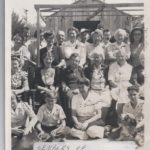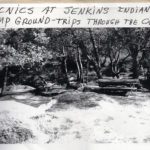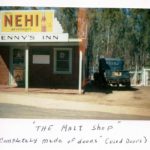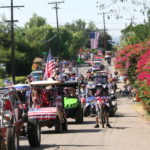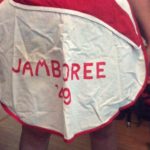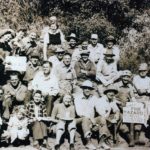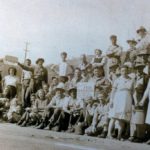Living on the Hill in 1940s
Life in Suncrest/LaCresta in the 1940s
Between 1941 and 1947 the population jumped from 200 to 1,000. Crest village was considered to be the most up and coming community in the valley. The 1943 property value statistics showed a rise from $2,500 for a two-bedroom house to $6,000.
During the war years, the weekend cabins became permanent homes with the population rising to approximately 1,300 people. The community had its own aircraft warning system, air-raid service, fire department, and Red Cross. Most of the eligible men were either in defense work or in the service.
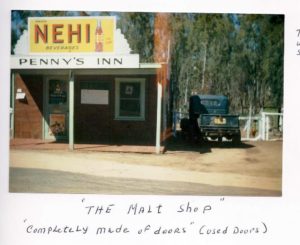 An article dated 1947 tells us that business in the Suncrest/La Cresta area was increasing all the time. There were two grocery stores in the area (Suncrest Market and La Cresta Store) as well as three garages (one known as Richey’s Crest Garage), a drugstore (Suncrest Pharmacy), malt shop (Penny’s Inn), department store (Hilltop Department Store), barber shop, fixit shop, and a new realty company. There had been a great amount of mineral deposits found in the vicinity and also one of the few white granite quarries in this part of the county. An ad in the Jamboree program advertised, “Dr. Stanley Kubik, Chiropractor Physician and Physiotherapist, announces the opening of his present office at 277 Highline Trail, La Cresta. Dr. and Mrs. Kubik have a completely furnished view apartment available to anyone desiring a complete rest while taking a series of treatments or to rent to anyone wishing to enjoy a lovely mountain vacation.”
An article dated 1947 tells us that business in the Suncrest/La Cresta area was increasing all the time. There were two grocery stores in the area (Suncrest Market and La Cresta Store) as well as three garages (one known as Richey’s Crest Garage), a drugstore (Suncrest Pharmacy), malt shop (Penny’s Inn), department store (Hilltop Department Store), barber shop, fixit shop, and a new realty company. There had been a great amount of mineral deposits found in the vicinity and also one of the few white granite quarries in this part of the county. An ad in the Jamboree program advertised, “Dr. Stanley Kubik, Chiropractor Physician and Physiotherapist, announces the opening of his present office at 277 Highline Trail, La Cresta. Dr. and Mrs. Kubik have a completely furnished view apartment available to anyone desiring a complete rest while taking a series of treatments or to rent to anyone wishing to enjoy a lovely mountain vacation.”
In the late 1940s and into the 1950s most families had only one car. That car was used by the working member of the household every weekday. Weekends it was used for grocery shopping, errands, and family entertainment. So when door to door deliverymen began appearing on the hill, most ladies of the house were happy to see them.
The Fuller Brush man brought mops and brooms, brushes of all kinds, and cleaning supplies. There was the man who picked up their dry cleaning and returned it the following week. From the Watkins man they bought spices, flavorings, cold preparations, ointments, and various remedies.
Conklin’s Bakery on El Cajon Blvd. sent out delivery wagons one day a week. There were double doors at the rear of the van with pull out drawers that held bread, rolls, cakes, pies, donuts, and all manner of baked goods. Many pots of coffee were perking while waiting for the bread man to deliver his wares.
There was the man from Golden Arrow Dairy who delivered milk, half and half, cottage cheese, and other dairy products. No one locked their doors in those days, so if you weren’t home, the milkman came in and put the order in the fridge, adjusting it as necessary to leave more or less milk as needed. It is believed milk always tasted colder and more refreshing when poured from a glass bottle instead of plastic or wax cartons.
With this growing community, issues such as the ongoing water shortage and fire protection became more critical.
More Amenities Come to the Crest in the 1940s
Trash Service
In the 1940s when the local ravine was filling up, a new business came to Crest – Elmer’s Trash Service. Elmer’s truck was probably a 1.5 ton flatbed and is remembered to have sheets of plywood for sides. Cost for service was $3 every two months.
Round Trip Shuttle Starts
In 1941, a shuttle was in service to transport workers to Consolidated Vultee, an aircraft factory in San Diego.
The Crest Public Utility District
The first water district was formed in July of 1944, after which the water systems of Suncrest and La Cresta were turned over to the District for operation. This combined the La Cresta and Suncrest wells into a mutual water system serving the entire Crest’s water supply. Water continued to be a problem and eventually a new pumping plant, water line, and reinforced concrete reservoir was installed and put into operation.
In 1947 the community had to take critical measures to continue to have water. Stanley Andrews, the sporting goods businessman, was living at the bottom of the La Cresta hill and had water on his property. He generously allowed the community to pump water up the hill from his land to keep the taps flowing. This required a huge volunteer effort to lay a pipeline up the three miles to Crest and hook up to this source at the Andrews’ place.
In the meantime, the Crest Public Utility District was led to annex to Helix Water District in order to get entitlement rights to import water from San Diego County Water Authority. Helix built a 6” steel and concrete line pipe that carried water 7,625 feet uphill to Crest from the Helix Water District’s flume line. Two concrete water storage tanks with a capacity of just under one-half million gallons were installed on Crest mountaintops in 1949 and 1959. CPUD continued to pump water up the hill until 1985. Bill Jenkins worked for the Crest Public Utility Company for three years doing everything from reading meters to helping to bring the water pipes up the hill. Bill said, “You would never know where the water pipe would be with the summer heat. Sometimes it would get shoved onto the dirt road and you’d have to be careful not to run over it.” Water was obtained from the Colorado River from the water mains of La Mesa, Lemon Grove, and Spring Valley Irrigation District. In 1950, numerous fire hydrants were installed throughout the Crest community.
December 1949 Marks Snow in Crest
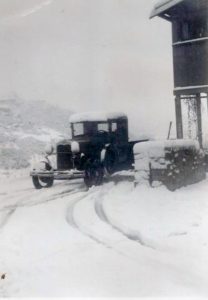 Residents of Suncrest and La Cresta were surprised when they awoke to find two inches of snow on the ground. By Tuesday night, reports were of six inches and up. On that night, the road to Crest was closed for a short time. It was the heaviest snow since 1882 as shown in this photo on Crest Drive.
Residents of Suncrest and La Cresta were surprised when they awoke to find two inches of snow on the ground. By Tuesday night, reports were of six inches and up. On that night, the road to Crest was closed for a short time. It was the heaviest snow since 1882 as shown in this photo on Crest Drive.
Creation of the Crest Volunteer Fire Department- 1942-1951
The first firefighting equipment on the hill in 1942 consisted of barrels of water hauled on a trailer behind a private automobile. It was put together by members of Suncrest. This trailer was a car body frame from an old Ford. Oil drums were welded on to transport water. Equipment on this trailer consisted of three back pumps, one fireman’s ax, one brush hook, one McCloud rake, four buckets and three canteens. Volunteers who manned the trailer provided shovels. The trailer was attached to the vehicle that arrived first. It was parked to the left of the Suncrest Store. The volunteers were made up of retired men, local businessmen, high school students, or “whoever happened to be home that day.”
Because of the many fire hazards, a few of the residents conceived the idea of having a volunteer fire department. This aroused the citizens of ”the hill” to purchase a small used pumper unit from government surplus for $276. That unit was eventually installed on an old Corbett crash truck purchased from North Island Naval Air Station. To buy this equipment, the whole hilltop worked together to raise money with barbeques and horse shows, dinners and dances, rummage sales, variety shows, and more.
The Ladies Auxiliary of the Crest Volunteer Fire Association
 At the same time, the Ladies Auxiliary of the Crest Volunteer Fire Association was formed, adopting their first set of bylaws in September 1947. The Crest Women’s Fire Auxiliary was not only very active socially, they also trained on the equipment and answered several calls when the men were not available. Their purpose was to operate equipment in the absence of men, assist with social affairs, and to obtain and furnish rations in emergencies.
At the same time, the Ladies Auxiliary of the Crest Volunteer Fire Association was formed, adopting their first set of bylaws in September 1947. The Crest Women’s Fire Auxiliary was not only very active socially, they also trained on the equipment and answered several calls when the men were not available. Their purpose was to operate equipment in the absence of men, assist with social affairs, and to obtain and furnish rations in emergencies.
Then the idea of a horse show was presented as an annual event, which continued for five years- from 1947 to 1951. In conjunction with the horse show there was a big barbeque and a midway as well as raffles which offered chances on groceries and other prizes. These “Crest Jamborees” helped provide the materials needed to start construction on the firehouse and the purchase of a second truck.
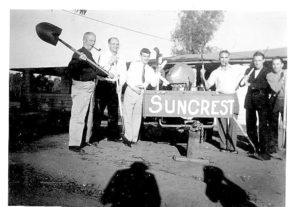
Crest Builds Its First Fire Station – Construction of the station was done by volunteer residents of Crest. The building site which is still used for our station was leased to the volunteer fire department for 99 years from the water district, adjacent to where they later built their office.
1942 – First Catholic Church St. Louise de Marillac Church
The first Holy Mass was  offered in the Suncrest Clubhouse April 19, 1942 by Rev. Frederick Coupal, in whose care the bishop had placed the new parish. The clubhouse could not be expected to lend itself to religious solemnity and therefore a parcel of land was acquired on Suncrest Blvd. at the corner of Eucalyptus Avenue where a long-vacant and modest little home stood. The house was converted into a chapel.
offered in the Suncrest Clubhouse April 19, 1942 by Rev. Frederick Coupal, in whose care the bishop had placed the new parish. The clubhouse could not be expected to lend itself to religious solemnity and therefore a parcel of land was acquired on Suncrest Blvd. at the corner of Eucalyptus Avenue where a long-vacant and modest little home stood. The house was converted into a chapel.
In November 1944, the Most Reverend Bishop Buddy purchased the home of Edmund Dupuis at 339 Estornino Lane in Suncrest, in order to provide the first parish rectory. The rectory was later sold to James Donovan and the priest took up residence in the Nosbonne home at 129 Albatross Place, Suncrest. In May of 1950, the present spot was chosen for the proposed church and purchased from Edward Meyer for $600. Ground was broken on August 27, 1950. The first Holy Mass was sung by Father Goodrow before an overflowing congregation on Christmas midnight, 1950.
1947 – House to House Mail Begins
Thanks to the combined efforts of Elmer Hamm and the Fire Association, house mail delivery was established. A survey was made of the community and house numbers were distributed to the home owners. Also, through the cooperation of the El Cajon Valley Chamber of Commerce, street markers were installed in conjunction with the new mail service.
Entertainment on “The Hill” in the 1940s
The La Cresta Women’s Club and the Suncrest Clubhouse were the center of activities for the communities in the early 1940s. The Suncrest Clubhouse was also a hangout for the Crest “kids.” It was here they held their dances, Christmas parties, youth meetings, etc. The Junior Fire Girls, Crest Teener’s Club and Young-uns, as well as the Junior Firemen, sponsored by Crest Volunteer Firemen, occupied the kids’ time during this decade.
Music and dancing were still the highlights for the adults at the clubhouse. For the teenagers, in the ‘40s preceding the war and shortly after, Gene Wilcox came on the scene. Gene had a fabulous collection of records and generously gave his time so one and all could hear strains of Glenn Miller, Tommy Dorsey, Benny Goodman, Artie Shaw, Bob Crosby, Jimmy Dorsey, and many more. Jitterbugging was the rage and created quite a sight.
“Movies under the Stars” at the Suncrest Clubhouse in 1946 was very popular for a time. A familiar sight on “the hill” was Bozzy Willis, who drove a unique home-built, fenderless hot rod named Steam Beans. Bozzy, a bachelor and longtime resident of La Cresta, provided free movies during many summer weekends in the front area of the Suncrest Clubhouse. He ran the 16 mm projector. He had access to an “inside source” in San Diego where he borrowed pre-released films. Eventually Bozzy was forced to discontinue showing the free movies because legal difficulties were encountered.
From 1947 to 1951, the volunteer fire department held annual “Jamborees” lasting multiple days which brought as many as 2000 persons visiting the resort community. Events included a children’s field day held in Sunrise Park (South Lane Park), dances at the Suncrest Clubhouse, barbeques, and a horseshow. The event was sponsored to raise money for the volunteer fire department.
The Crest Observation Post.
During World War II there was an observation post located behind the Suncrest Clubhouse (what is now the Community Church). It was manned by volunteers. Called the Ground Observer Corps, the volunteer organization was assigned the task of observing and reporting movement of all aircraft over the landward areas. The purpose was to track aircraft flying over San Diego County to report possible activity of a Japanese invasion.

The post was in a very small building and consisted of a chair, a telephone, and whatever magazines could be rounded up for the observers’ use. The volunteers worked in four hour shifts and the post was manned 24 hours a day. When a plane flew over, the observer would call the tracking station located in Santa Ana where they had a very large map of the area. On this map the trackers placed miniature airplanes, and plotted the course and direction of the plane based on the observers’ information. The high school boys would generally take a night shift so they could get up in the mornings and go to school. It was all part of people doing what they could for the war.
Mountain View Road and the Crest Civic League – 1948-1951
The road through to Harbison Canyon did not happen overnight. “That road was one of the first major civic improvements undertaken by the newly formed Crest Civic League in 1948. The road at that time only went out about a mile. Elmer Hamm was very persistent in his letter writing to the Board of Supervisors, representing Crest Civic League, Crest Country Club, and Crest Volunteer Fire Department. After many excuses and delays by the board, Mr. Hamm made the proposal to have a fire truck trail bulldozed into Harbison Canyon by the State Forestry, thus getting our foot in the door for paving in the future. In a joint effort, the county did the field surveys and the Forestry Service bulldozed. The fire trail was finally opened in August 1952. There is no information on when the county actually took over the road and paved it.”
1946 First Recorded July 4th Event
The first recorded Crest July 4th event was in 1946. Crest has always embraced this special holiday filled with patriotism and love for our great country. Did you ever wonder what the first parades were like? According to Dorothy Miller, long time Crest resident, “One of the first July 4th parades I remember back in the 1940s was a small, informal parade. Most of the 15 or so participants either walked or rode on their decorated bicycles starting at the Suncrest Clubhouse (which is now the church) and ending around the fire station or first store. One particular recollection that sticks in my mind was that one year when little Richie Younghusband brought his large goose to the parade, put a string around its neck, and walked the entire parade route. Most of the participants were children who decorated their bicycles with crepe paper. There were also cars and horses.
“The unique factor of this ongoing event was that the parade was never planned. One never knew who would show up to march in the parade. One year there was even a plane in the parade!”
December 1949 Marks Snow in Crest
Residents of Suncrest and La Cresta were surprised when they awoke to find two inches of snow on the ground. By Tuesday night, reports were of six inches and up. On that night, the road to Crest was closed for a short time. It was the heaviest snow since 1882 as shown in this photo on Crest Drive
